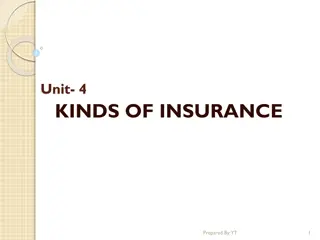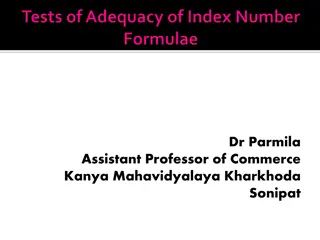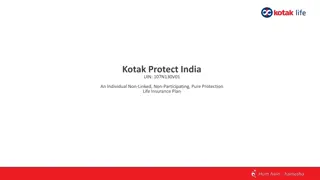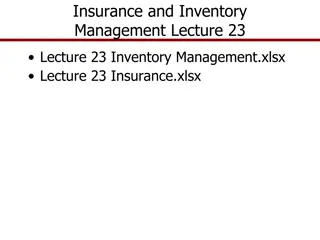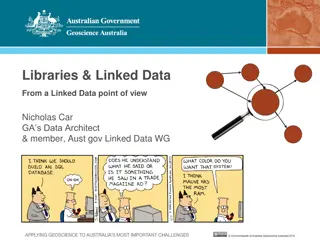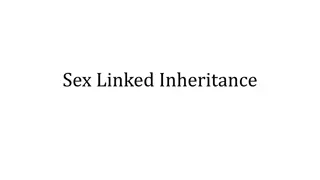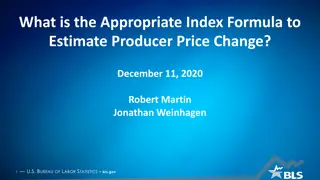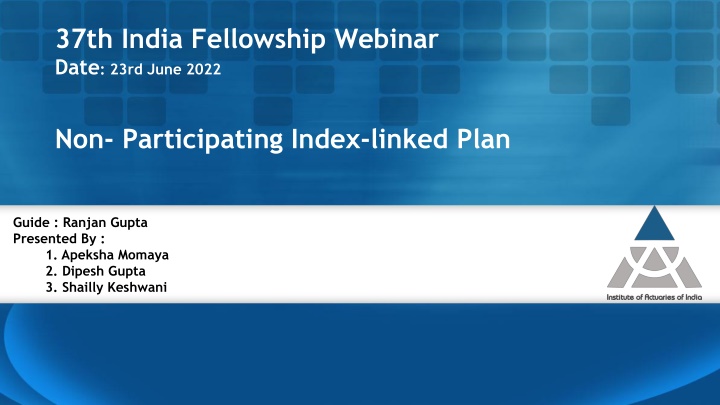
Innovative Product Design for Index-Linked Insurance Plans
Explore the intricacies of non-participating index-linked insurance products, including design specifics, risks, reserving frameworks, benchmark selection, and investment strategies. Understand the nuances of product categories like Endowment and Universal Life, offering a blend of guaranteed benefits and market performance linkage. Dive into the regulatory considerations and safeguards required for a successful launch in the dynamic insurance landscape of India.
Download Presentation

Please find below an Image/Link to download the presentation.
The content on the website is provided AS IS for your information and personal use only. It may not be sold, licensed, or shared on other websites without obtaining consent from the author. If you encounter any issues during the download, it is possible that the publisher has removed the file from their server.
You are allowed to download the files provided on this website for personal or commercial use, subject to the condition that they are used lawfully. All files are the property of their respective owners.
The content on the website is provided AS IS for your information and personal use only. It may not be sold, licensed, or shared on other websites without obtaining consent from the author.
E N D
Presentation Transcript
37th India Fellowship Webinar Date: 23rd June 2022 Non- Participating Index-linked Plan Guide : Ranjan Gupta Presented By : 1. Apeksha Momaya 2. Dipesh Gupta 3. Shailly Keshwani
Introduction Precious Life Insurance Company is a well-established Company in India selling ULIP and conventional non-par savings products With an intend to tap the potential market, It now plans to introduce new index- linked product Marketing team has suggested a design that will credit regular interest on the account balance of the policyholders The marketing team has suggested the benchmark index for the product could be a combination of a yield on Government bond and an Equity index www.actuariesindia.org
Agenda We as Product development Actuary are here to discuss the below : How a non-participating index linked product design works including the key risks faced The reserving framework applicable for such products in India The merits of selection of the external benchmark index as proposed by marketing team The design of investment framework backing such product portfolio The possible reservations from the IRDAI and how could these be addressed through appropriate safeguards www.actuariesindia.org
Product Design Index Linked product is not necessarily a new category and could be categorized into Par, Non-Par, ULIP etc. A general rule of index-linked product is that some of the benefits would be linked to the performance of an underlying index However, a minimum non zero interest floor rate will have to be defined For a non-par index linked product, the benchmark rate could be defined as benchmark returns less/plus spread Such spread will remain constant throughout the policy term www.actuariesindia.org
Product Design 1. Endowment The Premium will be derived based on the sum assured Maturity value would be guaranteed amount plus index linked benefit 2. Endowment with Survival Benefits In addition to 1 above , we could also provide some survival benefits Such survival benefits could be in form of additions payable along with other event-based benefits or in form annual /half-yearly payouts 3. Universal Life Total Premium is split in two components, saving premium and non-saving premium Non-saving premium is utilized for cost of insurance , expenses including commission, cost of capital and the profit margin Savings premium could now be accumulated through regular credit of interest or could be converted to income form based on the index 4. Modified Universal Life Instead of splitting the premium components , the charges are explicitly defined and deducted from the premium www.actuariesindia.org
Product Design Benchmark Index 10Year Gsec+ Nifty 50 Accrued Benefits Annual Interest rate credits on Annualised Premium from first year till the end of the policy term 10 Years Gsec yield - 200 bps + 25% of growth in Nifty 50, subject to minimum 0% 10 times of Annualised Premium + Accumulated Interest, if any Interest rate for credits Death Benefit Maturity Benefit Guaranteed Maturity Benefit (Return of Premium)+ Accumulated Interest Annual Interest Credit Premium Payment Policy Start Policy Term PPT Maturity = Guaranteed Maturity Benefit + Accumulated Interest www.actuariesindia.org
Key Risks Risk involves uncertainty about the effects/implications of an activity often focusing on negative, undesirable consequences Policyholder s Reasonable Expectation Asset-Liability Management System and Administration Index New & Complex Product design (IT systems) Un-realistic Expectations through mis- selling Duration Mismatch Liquidity Non- Policy Servicing availability in future Basis Guarantee Minimum Credit of Interest rate of 0% Change in structure www.actuariesindia.org
Other Risks Systemic Risk Re-investment Risk Re-insurance Risk Credit Risk Mortality Risk Expense Risk Lapse Risk Catastrophe Risk Reputational Risk Regulatory Risk; etc www.actuariesindia.org
Reserving Framework No specific regulations exists for the Index Linked Insurance Products (ILIP) IRDAI (Assets, Liabilities and Solvency Margin of Life Insurance Business) Regulations, 2016 would be applicable Actuarial Investigations Consideration must be given to the liabilities, the assets and the relationship between the two The Appointed Actuary should be satisfied as to the resilience of the financial position of the company He should be satisfied with the accuracy/completeness of the data and ensure that appropriate valuation procedures & documentation exists Have regard to policyholders' reasonable expectations when determining the value of the liabilities www.actuariesindia.org
Reserving Framework Liability Valuation Mathematical Reserves shall be determined for each contract using prospective method and gross premium valuation approach Use of other methods is not barred however; the amount of calculated reserve is expected to be at least equal to the amount that shall be produced by Gross Premium Method. Consideration to be given to all prospective contingencies under which any premiums or benefits may be payable The determination of the amount of liability under each policy shall be based on prudent assumptions The value of each such parameter shall be based on the insurer s expected experience and shall include an appropriate margin for adverse deviations (MAD) The method of calculation of the amount of liabilities and the assumptions for the valuation parameters shall not be subject to arbitrary discontinuities from one year to the next www.actuariesindia.org
Reserving Framework at an appropriate rate of interest The gross premium method of valuation shall discount the following future policy cash flows Additional considerations for ILIPs Onerousness test of interest rate up and down risk Onerousness test of surrender up and down risk Stochastic techniques required to manage interest rate risk The Appointed Actuary might have to establish additional provisions in respect of the following substandard lives ; Lapsed policies; Options available under policies; Guarantees available under policies; variations in rates of exchange; Incurred But Not Reported claims If actual expense experience has not been considered for the valuation The provision must at least equal that required if the company were to close to new business one year after the valuation date www.actuariesindia.org
Reserving Framework Asset Valuation Inadmissible assets as per ALSM regulations 2016 should be placed with value 0 All other assets must be valued in accordance with the Regulations then applicable Solvency Margin Solvency factors should be same as those used for Non-Linked Non-Par Individual Life Other than Term products Sum At Risk for solvency margin calculations is defined as - an amount payable in consequence of death or any other contingencies - the present value of annuity benefit or installment payments of any other kind in consequence of death or any other contingencies - Less, mathematical reserve in respect of the policy In the computation of the total sum at risk, ignore the contracts for which the sum at risk is a negative figure or does not exist Solvency Margin i.e., available solvency margin / required solvency margin shouldn t be less than the control level of solvency margin (150%) www.actuariesindia.org
External Benchmark Index Merits of the proposed external benchmark index A transparent and objective approach Cost efficient Easily available Easy to explain to the policyholder Govt bond and Equity investment would compliment each other Government Bond Index Very low risk of default This will be appropriate if the risk appetite of the policyholders are low Downside protection Possible index: 10year Gsec Equity Index Higher risk but higher expected returns Appropriate if the risk appetite of policyholders is high Some protection against Inflation Possible index: NIFTY 50 www.actuariesindia.org
Investment Framework The basic investment principles of a life insurance company can be stated as a) To minimize risk, a company should select investments that are appropriate to the nature, term and currency of the liabilities b) The investments should also be selected to maximize the overall return on the assets, where overall return includes both investment income and capital gains c) The extent to which the appropriate investments referred to above may be departed from in order to maximize the overall return will depend, amongst other things, on the extent of the company's free assets and the company s appetite for risk www.actuariesindia.org
Investment Framework Asset classes to consider for non-participating ILIPs 1) Government Bonds Will be useful to meet the accumulated guarantees Useful to match the liabilities where the benchmark index is Government Bonds Care needs to be taken when the term of bond is different than the index chosen 2) Equities Useful to match the liabilities where the benchmark index is Equity index Real returns High risks but generates potentially higher returns 3) Corporate Bonds Will earn higher returns than Government bonds Fixed income corporate bonds Market Linked Debentures where the returns are linked to G-sec or Equity index Low availability of bonds (specially Market Linked bonds) in India Higher Credit Risk, Marketability Risk Duration mismatch and reinvestment risks due to shorter term of bonds www.actuariesindia.org
Investment Framework 4) Derivatives To hedge the key financial risks: Interest rate risk in bonds Equity market crashing Active management is required Derivates are available for shorter term Derivate market in India is not very deep and liquid The risks should be carefully assessed Could be costly 5) Mutual Funds Could invest in mutual funds which has a mix of bonds and equity Higher returns than Bonds Reduces the risk of direct equity exposure www.actuariesindia.org
Investment Framework 6)Money market instruments Include Treasury bills, CBLO (Collateralized borrowing and lending obligation), Certificates of Deposits, short term Fixed Deposits etc. To manage liquidity Other considerations Overall portfolio to be complaint with IRDAI Investment Regulations 2016 Diversification to reduce the concentration risk Uncertainty due to timing of benefit to be considered Asset liability management risks Default risk Reinvestment risk www.actuariesindia.org
IRDAI- Reservations and Safeguards Reservations IRDAI (Regulatory Sandbox) Regulations 2019 promotes innovation beneficial to insurance in India; is in the interest of the policyholders; is conducive for the orderly growth of the industry; would promote increase in insurance penetration in the country; Complexity of the product design Reserving approach for such products Asset liability management risks Difficulty in accessing Policyholder s Reasonable Expectations Allowance of surrender penalty www.actuariesindia.org
IRDAI- Reservations and Safeguards Safeguards Simple Product design Chosen Index is widely known to the policyholders Variants which are linked to a single index Customer disclosures and transparency Product Pricing ensures reasonable and fair returns to the policyholder Additional solvency margins and global reserves Reserving to capture the future likely movement of the index Surrender Penalty in form of Market Value Adjustment www.actuariesindia.org





